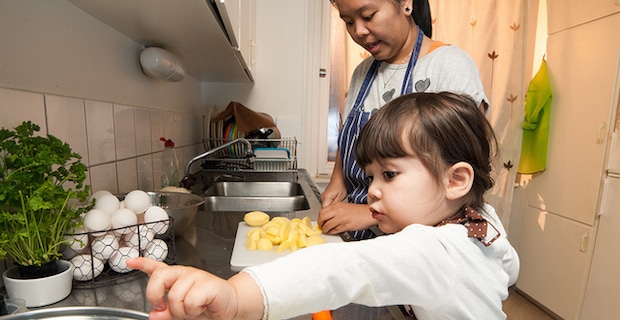
Need a quick health fix? Then look no further than your kitchen – it’s there you’ll find the real fountain of health. If you are looking to get health issues under control, your kitchen is an excellent place to start. Here are 5 reasons I urge everyone to bypass the boxes, pass on prepared foods, retreat from restaurants and make your kitchen your go-to source for sustainable health:
1. Home Cooked Meals Are Nutrient Powerhouses. McDonalds? Not So Much
Now I’m not saying that all restaurant food will short-change you nutritionally, but most fast food, “family style” and “casual” restaurants will. For them, it’s not about your health, it’s about their profits. To maximize them, the cheapest ingredients possible are used in order to “pass the savings on” to you. As a result, your meals’ inexpensive ingredients will come at a high cost to your health, consisting mostly of raw materials from large-scale industrial farms and feed lots, where GMO crops, nutrient-depleted soil, pesticides and antibiotics are the order of the day. Hardly the ideal nutritional environment and not very appetizing either. Whereas, when you make your own meal with fresh, local and/or organic ingredients, each bite delivers loads of bio-available, health-supporting nutrients.
2. Home Cooking Puts Money in Your Pocket
Not to sound like your Depression-era grandpa, but dinner out once a week plus a few deli lunches is akin to lighting money on fire. Douse the flames by getting into a home cooking groove, which will also deliver the added benefit of leftovers for lunch or dinner the next day. Cutting back to just one or two dinners out a month and brown-bag lunches can save you roughly $2,000 -$4,000 a year, which healthfully-speaking, could be better spent on fresh, local produce, grass-fed meats and dairy from the farmers’ market. You could also use it for a CSA (community supported agriculture) membership, which will give you exclusive access to deliveries of fresh, local, seasonal produce, no supermarket required. For a list of over 4,000 CSAs visit LocalHarvest.com.
Read more about healthy eating on a budget
3. Cooking at Home Gives You Control
Sure, restaurant meals are fun and leave you without a sink full of dishes, but you have to keep in mind that even the best restaurants, may be using unhealthy oils or slipping in scoops of extra sugar and salt. At home, you’re in control. You’re in charge of portion size and what does or doesn’t get slipped onto your plate. When you’re your own top chef, you guarantee that there will be no surprises, weird additives or allergens that can make you fat or ill.
4. Cooking at Home Sets a Good Example
Cooking at home is a great lesson for the kids and a wonderful opportunity to bond over a shared activity. It’s also an opportunity to teach them an important life skill. Cooking isn’t a mysterious activity that just somehow happens – good food is a hands-on affair, where creativity and imagination can make playing with food fun (and for some, a career). The lesson of self-reliance is the meal that lasts forever, so let’s get cookin’!
5. Closer-to-home-cooking Should be Your Fallback
If you are going to eat out, your best nutritional bets are closer-to-home-cooked, organic and farm-to-table style restaurants, which use more nutritionally-dense, fresh, local and organic ingredients to make your meal. Keep in mind though, too much of even a good thing can still hit wallets and waistlines hard, so make dining out a rare treat, not your default setting.
BE WELL SOLUTIONS:
“But Doc, I have NO time to cook at home!!” I hear it every day, and it’s the number one reason most people fail to do it. Believe me, I get it – I’ve said it myself, but over the years, I’ve learned that cooking at home is one of those fundamental, health-supporting behaviors. You have to commit to it, just like exercise and getting good sleep. To help make the process a bit easier, here are a few time-saving kitchen tips – and feel free to share yours in the comments section:
1. Get plugged in. A classic Crock-pot or slow-cooker is a great way to make soups, stews and more, without having to dedicate more than a few minutes to assembling the ingredients and hitting the “on” switch. Come back in a few hours and dinner is served. Doesn’t get much simpler than that.
2. Play with your food. One of the best (not to mention fun) kitchen gadgets I’ve bought recently is a “spiralizer,” a clever little device that slices veggies into long, spaghetti-like strands. New favorite meal, served hot or cold: spiralized zucchini with home-made pesto, caramelized onions and sautéed veggies. Ah, bellissima!
3. Don’t just stand there. A lot of kids are used to passively watching parents cook. Get them involved! Have them help out with prepping, chopping or even simply stirring ingredients not only to aid with meal prep but also to help the actual cooking process.
Read more about why cooking with kids makes nutritional sense
4. Shop with a list – and cook ahead. To win the battle, you need a battle plan – so get that shopping list ready. But first, plan your meals for the week ahead. Based on the plan, put the list on your phone adding to it as needed during the week. Set aside a few hours to make the meals ahead and freeze them so they’re ready when you are.
5. Shortcut strategically, while keeping health top of mind. Stock the pantry with healthy, organic “convenience” foods so you can put a meal together quickly, without sacrificing nutrition. Great basics to keep on hand include: frozen organic veggies like spinach, broccoli and cauliflower; washed and bagged organic greens; canned organic beans in BPA-free cans; pole-caught tuna; capers; olives and sauerkraut to name a few.
This article originally appeared on DrFrankLipman.com.
Image: Peter Dahlgren










